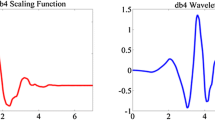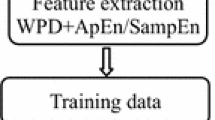Abstract
Feature extraction is a vital part in EEG classification. Among the various feature extraction methods, entropy reflects the complexity of the signal. Different entropies reflect the characteristics of the signal from different views. In this paper, we propose a feature extraction method using the fusion of different entropies. The fusion can be a more complete expression of the characteristic of EEG. Four entropies, namely a measure for amplitude based on Shannon entropy, a measure for phase synchronization based on Shannon entropy, wavelet entropy and sample entropy, are firstly extracted from the collected EEG signals. Support vector machine and principal component analysis are then used for classification and dimensionality reduction, respectively. We employ BCI competition 2003 dataset III to evaluate the method. The experimental results show that our method based on four entropies fusion can achieve better classification performance, and the accuracy approximately reaches 88.36 %. Finally, it comes to the conclusion that our method has achieved good performance for feature extraction in EEG classification.

Similar content being viewed by others
References
Nguyen T, Khosravi A, Creighton D (2015) Fuzzy system with tabu search learning for classification of motor imagery data. Biomed Signal Process Control 20:61–70
Nguyen T, Khosravi A, Creighton D et al (2015) EEG signal classification for BCI applications by wavelets and interval type-2 fuzzy logic systems. Expert Syst Appl 42(9):4370–4380
Torres-García AA, Reyes-García CA, Villaseñor-Pineda L et al (2016) Implementing a fuzzy inference system in a multi-objective EEG channel selection model for imagined speech classification. Expert Syst Appl 59:1–12
Liang S, Choi KS, Qin J, Pang WM, Wang Q, Heng PA (2016) Improving the discrimination of hand motor imagery via virtual reality based visual guidance. Comput Methods Programs Biomed 132:63–74
Gaur P, Pachori RB, Wang H et al (2015) An empirical mode decomposition based filtering method for classification of motor-imagery EEG signals for enhancing brain-computer interface. In: Proceeding of 2015 international joint conference on neural networks (IJCNN) IEEE, pp 1–7
Marchesotti S, Bassolino M, Serino A et al (2016) Quantifying the role of motor imagery in brain-machine interfaces. Scientific reports, p 6
Hu S, Tian Q, Cao Y et al (2013) Motor imagery classification based on joint regression model and spectral power. Neural Comput Appl 23(7–8):1931–1936
Chen L, Zhao Y, Zhang J et al (2015) Automatic detection of alertness/drowsiness from physiological signals using wavelet-based nonlinear features and machine learning. Expert Syst Appl 42(21):7344–7355
Aydın S, Saraoğlu HM, Kara S (2009) Log energy entropy-based EEG classification with multilayer neural networks in seizure. Ann Biomed Eng 37(12):2626–2630
Sushkova OS, Gabova AV, Karabanov AV et al (2015) Time–frequency analysis of simultaneous measurements of electroencephalograms, electromyograms, and mechanical tremor under Parkinson disease. J Commun Technol Electron 60(10):1109–1116
Xiao D, Mu Z, Hu J (2009) Classification of motor imagery EEG signals based on energy entropy. In: Proceeding of 2009 international symposium on intelligent ubiquitous computing and education, pp 61–64
Rui Z, Peng X, Rui C et al (2015) Predicting inter-session performance of SMR-based brain-computer interface using the spectral entropy of resting-state EEG. Brain Topogr 28(5):1–11
Tass P, Rosenblum MG, Weule J et al (1998) Detection of n:m phase locking from noisy data: application to magnetoencephalography. Phys Rev Lett 81(15):3291
Guo L, Rivero D, Pazos A (2010) Epileptic seizure detection using multiwavelet transform based approximate entropy and artificial neural networks. J Neurosci Methods 193(1):156–163
Zhang Z, Zhou Y, Chen Z et al (2013) Approximate entropy and support vector machines for electroencephalogram signal classification. Neural Regen Res 8(20):1844
Chen Z, Zhou H, Zhao L (2011) Decoding human right and left hand motor imagery from EEG single trials using sample entropy. In: Proceeding of 2011 international conference on IEEE electronics and optoelectronics (ICEOE), pp V4-353–V4-356
Ocak H (2009) Automatic detection of epileptic seizures in EEG using discrete wavelet transform and approximate entropy. Expert Syst Appl 36(2):2027–2036
Sharma R, Pachori RB, Acharya UR (2015) Application of entropy measures on intrinsic mode functions for the automated identification of focal electroencephalogram signals. Entropy 17(2):669–691
Acharya UR, Yanti R, Zheng JW et al (2013) Automated diagnosis of epilepsy using CWT, HOS and texture parameters. Int J Neural Syst 23(03):1350009
Kannathal N, Choo ML, Acharya UR et al (2005) Entropies for detection of epilepsy in EEG. Comput Methods Programs Biomed 80(3):187–194
Sakihara K, Inagaki M (2015) Mu rhythm desynchronization by tongue thrust observation. Front Hum Neurosci 9:1–10
Kwon G, Kim MY, Lim S et al (2015) Frontoparietal EEG alpha-phase synchrony reflects differential attentional demands during word recall and oculomotor dual-tasks. NeuroReport 26(18):1161–1167
Mormann F, Andrzejak RG, Elger CE et al (2007) Seizure prediction: the long and winding road. Brain 130(2):314–333
Tuncay C (2010) Entropy analyses of spatiotemporal synchronizations in brain signals from patients with focal epilepsies. arXiv preprint. arXiv:1002.3552
Bashar SK, Bhuiyan MIH (2015) Automatic feature selection based motor imagery movements detection scheme from EEG signals in the dual tree complex wavelet transform domain. In: Proceeding of 2015 IEEE international conference on telecommunications and photonics (ICTP), pp 1–5
Li X, Cui W, Li C (2012) Research on classification method of wavelet entropy and fuzzy neural networks for motor imagery EEG. In: Proceeding of 2012 IEEE international conference on modelling, identification & control (ICMIC), pp 478–482
Acharya UR, Fujita H, Sudarshan VK et al (2015) Application of entropies for automated diagnosis of epilepsy using EEG signals: a review. Knowl Based Syst 88:85–96
Kumar SP, Sriraam N, Benakop PG et al (2010) Entropies based detection of epileptic seizures with artificial neural network classifiers. Expert Syst Appl 37(4):3284–3291
Richman JS, Moorman JR (2000) Physiological time-series analysis using approximate entropy and sample entropy. Am J Physiol Heart Circ Physiol 278(6):H2039–H2049
Nicolaou N, Georgiou J (2012) Detection of epileptic electroencephalogram based on permutation entropy and support vector machines. Expert Syst Appl 39(1):202–209
Wang L, Xu G, Yang S et al (2012) Motor imagery BCI research based on sample entropy and SVM. In: Proceeding of 2012 sixth international conference on electromagnetic field problems and applications (ICEF), pp 1–4
Imran SM, Talukdar MTF, Sakib SK et al (2014) Motor imagery EEG signal classification scheme based on wavelet domain statistical features. In: Proceeding of 2014 international conference on electrical engineering and information communication technology (ICEEICT), pp 1–4
Gupta SS, Soman S, Raj PG et al (2014) Improved classification of motor imagery datasets for BCI by using approximate entropy and WOSF features. In: Proceeding of 2014 international conference on signal processing and integrated networks (SPIN), pp 90–94
Acknowledgments
The work is supported by National Natural Science Foundation of China (Nos. 61172134, 61671197 and 61601162).
Author information
Authors and Affiliations
Corresponding author
Ethics declarations
Conflict of interest
The authors declare that they have no conflict of interest.
Rights and permissions
About this article
Cite this article
Chen, S., Luo, Z. & Gan, H. An entropy fusion method for feature extraction of EEG. Neural Comput & Applic 29, 857–863 (2018). https://doi.org/10.1007/s00521-016-2594-z
Received:
Accepted:
Published:
Issue Date:
DOI: https://doi.org/10.1007/s00521-016-2594-z




